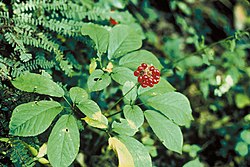Panax quinquefolius
Panax quinquefolius L.
| Ordre | Apiales |
|---|---|
| Famille | Araliaceae |
| Genre | Panax |
2n =
Origine :
sauvage et cultivé
| Français | |
|---|---|
| Anglais | Canadian ginseng |
- médicinal
Description
-
infrutescence
-
racine
-
répartition
Noms populaires
| français | |
| anglais | Canadian ginseng, American ginseng, ginseng, redberry |
| chinois | (Flora of China) ; si ren shen, xi yang shen |
Classification
Panax quinquefolius L. (1753)
- publié par Linné sous la forme quinquefolium, mais Panax est masculin.
synonyme :
- Aralia quinquefolia (L.) Decne. & Planch. (1854)
Cultivars
Histoire
-
Aureliana Canadensis, Lafitau, 1718, Mémoire concernant la précieuse plante du gin-seng
-
Bigelow, 1817, American medical botany
-
Gin-seng à cinq feuilles, Descourtilz, Flore médicale des Antilles, 1829, 8:570
-
Millspaugh, 1887, American medicinal plants
Usages
Aralia quinquefolia Decne & Planch. GINSENG. North America. The root is collected in large quantities in the hilly regions of Ohio, western Virginia, Minnesota and other parts of eastern America for export to China where it is valued as a medicine. Some persons in this country are in the habit of chewing the root, having acquired a relish for its taste, and it is chiefly to supply the wants of these that it is kept in the shops [1].
- ↑ U. S. Disp. 636. 1865. (Panax quinquefolium)
Cultivated in the United States and Canada (recently especially in Marathon county, Wisconsin; British Colombia and Ontario) from the 1870s for exporting the roots to China (Hong Kong). Experimentally grown elsewhere in the U.S., Europe (Sweden, England, the Netherlands, France, Germany, Switzerland), Israel, Australia, New Zealand and Chile. Already commercially cultivated in China. The drug has been used in China and SE Asia as an antipyretic and as a stimulant or tonic like Panax ginseng.
Références
- Carlson, A. W. (1986) - Ginseng: America's botanical drug connection to the orient. - Econ. Bot. 40 (2): 233-249.
- Duke, J. A. - Ginseng: a concise handbook. Reference Publ. Algonac 1989: 273 p.
- Esdorn, I. (1958) - Der heutige Stand der Ginsengforschung. - Pharmazie 13: 556-562.
- Esdorn, I. (1960) - Die Ginsengwurzel auf dem heutigen Drogenmarkt. - Pharmazie 15: 75-81.
- Hemmerly, T. E. (1977) - A ginseng farm in Lawrence Country, Tennessee. - Econ. Bot. 31: 160-162.
- Hensley, D. L., S. Alexander & C. R. Roberts (eds. - Proceedings of the First National Ginseng Conference, 1979. Kentucky Univ. Lexington 1979: 124 p.
- Hosemans, C. (1996) - Australian ginseng: the paddock or the bush? - Austral. New Crops Newslett. 6: 8-10.
- Kitchener, A. (1996) - Crop profiles: Ginseng (Panax spp.). - Austral. New Crops Newslett. 6: 19-21.
- Lafitau, Joseph-François, 1718. Mémoire présenté à S. A. R. Mgr le duc d’Orléans [...] concernant la précieuse plante du gin-seng de Tartarie, découverte en Canada. Paris, Jospeh Monge.
- Motsch, Andreas, 2014. Le ginseng d’Amérique : un lien entre les deux Indes, entre curiosité et science. Études Épistémè, 26. Openeidtion et 10.4000/episteme.331
- Parsons, Christopher, 2011. Plants and Peoples: French and Indigenous Botanical Knowledges in Colonial North America, 1600–1760. en ligne
- Pelchat, André, 2003. La ruée vers le ginseng. The Beaver. en ligne
- Persons, W. S. - American ginseng: green gold., Ed. Rev. Bright Mountain Books Asheville 1994: 203 p.
- Roberts, C. R. (1980) - American ginseng (Panax quinquefolium L.). - Acta Hort. 96: 352 p.
- Thompson, G. A. (1991): Botanical characteristics of ginseng (pp 111-136) - In: L. E. Craker & J. E. Simon (eds.) - Herbs, spices and medicinal plants. - Recent advances in botany, horticulture, and pharmacology. 2 Haworth Press New York: 255 p.







